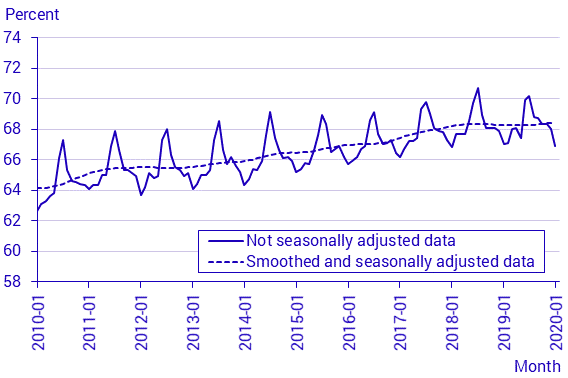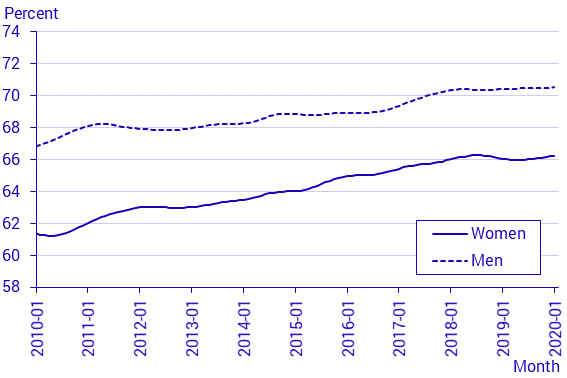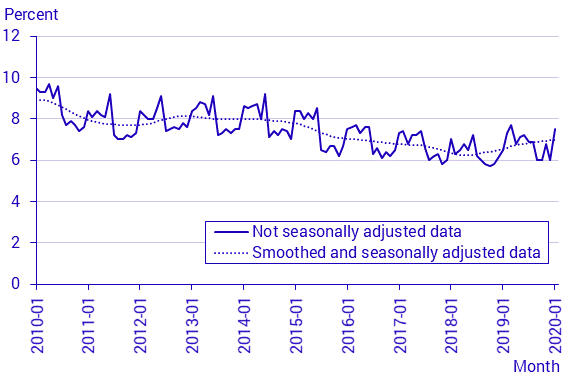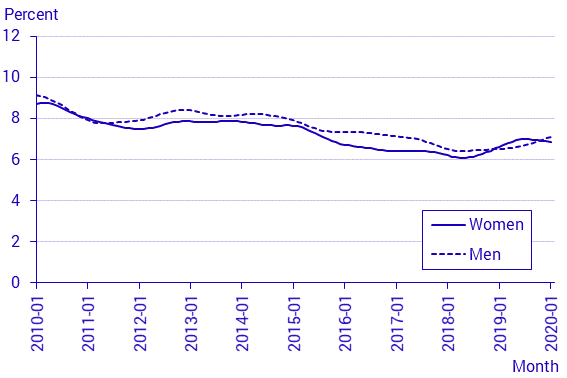Labour Force Surveys (LFS), January 2020
Labour force continued to grow
Statistical news from Statistics Sweden 2020-02-18 9.30
In January 2020, there were 5 034 000 employed persons. The unemployment rate was 7.5 percent, an increase of 1.0 percentage points. The average number of hours worked per week amounted to 135.8 million. Smoothed and seasonally adjusted data indicates an increase in both the employment and unemployment rates; the unemployment rate was 7.0 percent.
The reduced sample is associated with greater uncertainty in the individual monthly outcomes. This is reflected in larger uncertainty figures in the published tables. The sample will be expanded in the spring and new register information will be evaluated within the framework of the estimation procedure with the aim of reducing uncertainty. Supplementary information on the LFS is available at the end of this statistics news item.
In January 2020, there were 5 034 000 employed persons aged 15─74, not seasonally adjusted. There were 2 656 000 employed men and 2 379 000 employed women. The employment rate was 66.9 percent. The employment rate was 69.3 percent among men and 64.3 percent among women.
Smoothed and seasonally adjusted data indicates an increase in both the number of employed persons and the employment rate compared with recent months. In January 2020, there were 5 151 000 employed persons, which corresponds to an employment rate of 68.4 percent.
There were 4 498 000 employees aged 15─74 in January 2020, not seasonally adjusted. Among men, the number of employees was 2 254 000 and among women it was 2 244 000. There were 3 836 000 permanent employees in the same period. Among men, the number of permanent employees was 1 963 000 and among women it was 1 873 000.
There were 662 000 temporary employees. Among men, there were 291 000 temporary employees and among women there were 371 000 temporary employees. Compared with nearby months, smoothed and seasonally adjusted data shows minor changes in the number of permanent employees and in the number of temporary employees.
On average, the number of hours worked in January 2020 amounted to 135.8 million per week, not seasonally adjusted. Smoothed and seasonally adjusted data showed a minor change in the number of hours worked per week compared with recent months. On average, the number of hours worked amounted to 153.6 million per week in January 2020.
In January 2020, there were 410 000 unemployed persons aged 15─74, which is 59 000 persons more than a year earlier. The unemployment rate increased by 1.0 percentage points and amounted to 7.5 percent. There were 178 000 unemployed women and 232 000 unemployed men, which is an increase of 56 000 persons. The unemployment rate was 7.0 percent among women and 8.0 percent among men, an increase of 1.8 percentage points.
Among young persons aged 15─24, there were 122 000 unemployed persons, which corresponds to an unemployment rate of 22.1 percent. Among unemployed young people, 72 000 persons were full-time students.
Among persons aged 15–74, smoothed and seasonally adjusted data shows an increase in both the number of unemployed persons and the unemployment rate, compared with nearby months. There were 387 000 unemployed persons in January 2020, which corresponds to an unemployment rate of 7.0 percent.
Among young persons aged 15─24, smoothed and seasonally adjusted data shows minor changes in the number of unemployed persons and an increase in the unemployment rate. There were 126 000 unemployed young persons, which corresponds to an unemployment rate of 20.1 percent.
Supplementary information on the Labour Force Surveys (LFS)
The January LFS statistics are based on data collection carried out by Statistics Sweden's Data Collection Department in order to provide the most reliable description possible of the labour market. However, as Statistics Sweden has discontinued collaboration with an external supplier, who was responsible from May 2018 for data collection of 50 percent of the LFS sample, this means that the statistics are based on a reduced sample and thus, are more uncertain. This applies overall, but may be especially noticeable for estimates at a more disaggregated level.
Larger uncertainty figures for level estimates lead to larger uncertainty intervals. This also means that comparisons within one year are affected. Larger uncertainty figures require larger differences than before between the periods for a statistically significant change to be defined as such.
Seasonally adjusted and smoothed data are also affected, although in absolute terms, the effect is smaller than for level and change estimates, as the series are based on estimates from several points in time.
The survey sample will be expanded in the spring to address the issue of the small sample. In addition, Statistics Sweden will receive new data from the Swedish Tax Agency for the purpose of improving the estimation procedure and thereby further reducing uncertainty in the estimates.




Next publishing will be
2020-03-13 at 9:30.
Feel free to use the facts from this statistical news but remember to state Source: Statistics Sweden.
